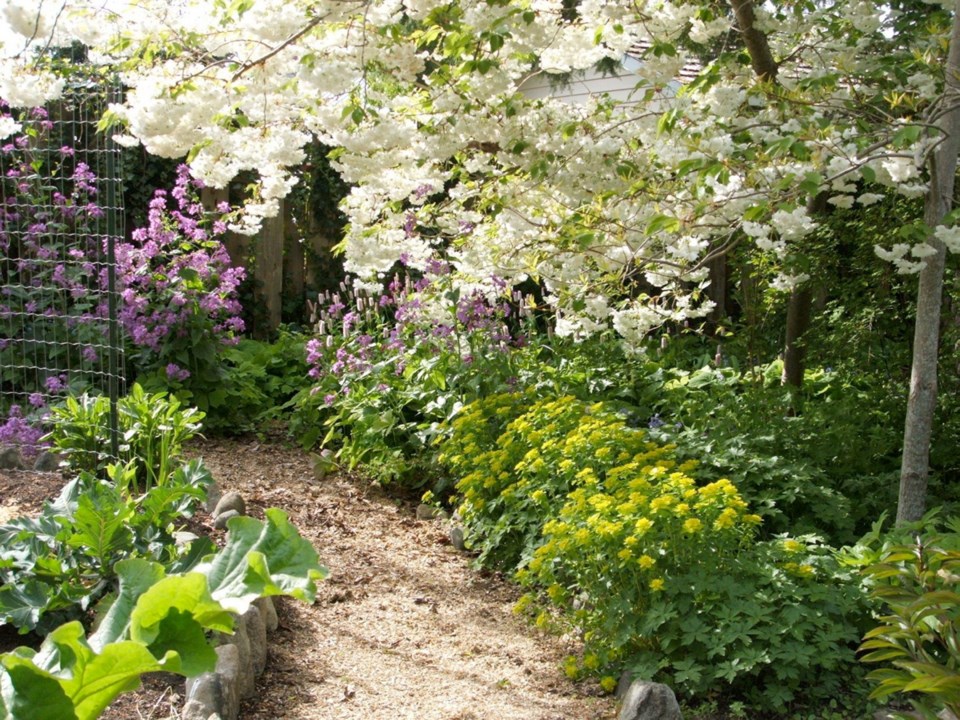Most home gardeners recognize and honour their gardening spaces as natural sources of enhanced health and elevated mood. We know intuitively what science now confirms: Contact with the soil and proximity to a rich diversity of plants benefit physical and mental health.
Those who follow reports from the David Suzuki Foundation will have read a recent article citing research from Harvard, the University of Helsinki and the American Public Health Association showing that a particular microbe in the soil can actually affect the brain in a way that reduces anxiety and improves mental agility. Another microbe, found in natural environments with a diversity of native plants, has been shown to benefit the human immune system.
There’s a reason for us to instinctively view our gardens as places of calming sanctuary and healing.
The Carefree Garden: Letting Nature Play Her Part, by Bill Terry (Touchwood Editions, 240 pages, paperback, $21.95). The Carefree Garden presents the simple charms of the mainly native and species plants in the author’s Sunshine Coast property as his “perfect” sort of garden. Contributing significantly to the garden as a happy place is a healthy measure of serendipitous disorder.
This is the third time I’ve become ensnared by a Bill Terry book. As with Beyond Beauty: Hunting the Wild Blue Poppy and Beauty by Design: Inspired Gardening in the Pacific Northwest (co-authored with Rosemary Bates), upon opening this book I became immediately captivated. The welcoming charm of the plants he loves are echoed in his writing, which is full of wry humour and personal anecdotes.
Terry imagines several encounters with Mother Nature, who usually appears in the form of a domineering bird “elegantly decked out in feathered finery.” When he inquires how to work in harmony with her in the formation of his new garden, she replies, “Go native.”
His expression of boredom with “dreary conifers, salal, sword ferns and stuff” arouses outrage at his blindness as she points out rhododendrons growing wild in his back yard, camas and sea blush, Calypso orchids, monkey-flower, fawn lilies and many more native gems.
Throughout, colour photographs bring to life “Nature’s portfolio of plants” and illustrate also beauty beyond flowers: “Mother showed me that if your eyes are well tuned, you don’t need flowers to find peace and harmony and colour and texture in her domain. It’s there in bark, and moss, and lichen, and fungi.”
As Terry continues to confer with Mother Nature on an expanded roster of native perennials, flower bulbs, shrubs and trees, they progress to simple species plants — tulips, roses, peonies. Many are easily grown from seed.
Then, in a later encounter, when “Mother Nature was wearing her black-crested jay outfit, preening her cobalt blue feathers in our birdbath,” she re-emphasizes that the secret to achieving “your perfect garden” is simplicity and easy care. She even has a formula for assessing plants: N x L + S.
N is a plant’s tolerance of neglect; L is “a measure of its loveliness.” Both are rated on a scale of 10. S, the multiple of the two, is the “coefficient of simplicity. That’s the measure of a plant’s suitability for a creaky and increasingly decrepit gardener, such as you, seeking the greatest possible satisfaction for the least possible effort.”
At that point, Mother (referred to here as “Ms. Bossy-Boots”) declares, “and now, you must grow hellebores” — plants with “a very high coefficient of simplicity.” On the N scale, hellebores have a rating of nine.
Serendipity and “happy accidents” are praised as playing “a leading role in developing a carefree garden.” Let desirable plants self-sow, creep, and run. Welcome the “disorderly conduct” of pleasant weavers like the Clematis viticella vines that “meander randomly among the branches of spring-flowering shrubs or small trees and redecorate them with fresh flowers.”
At the heart of the perfect garden, together with simplicity and serendipity, is “memory, with its associated stories.” Favourite plants moved from a previously cherished garden, plants grown from seeds gathered during travels, a patch of Erythronium (dog-tooth violets) growing over the resting places of beloved pets -- all such highly personal parts of a garden make it a rich repository of history.
“Ours is a garden of memories: a scrapbook of places visited, of people known and loved. Thus, the past shapes the present.”



